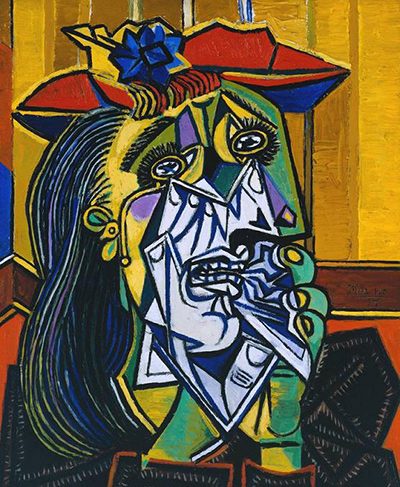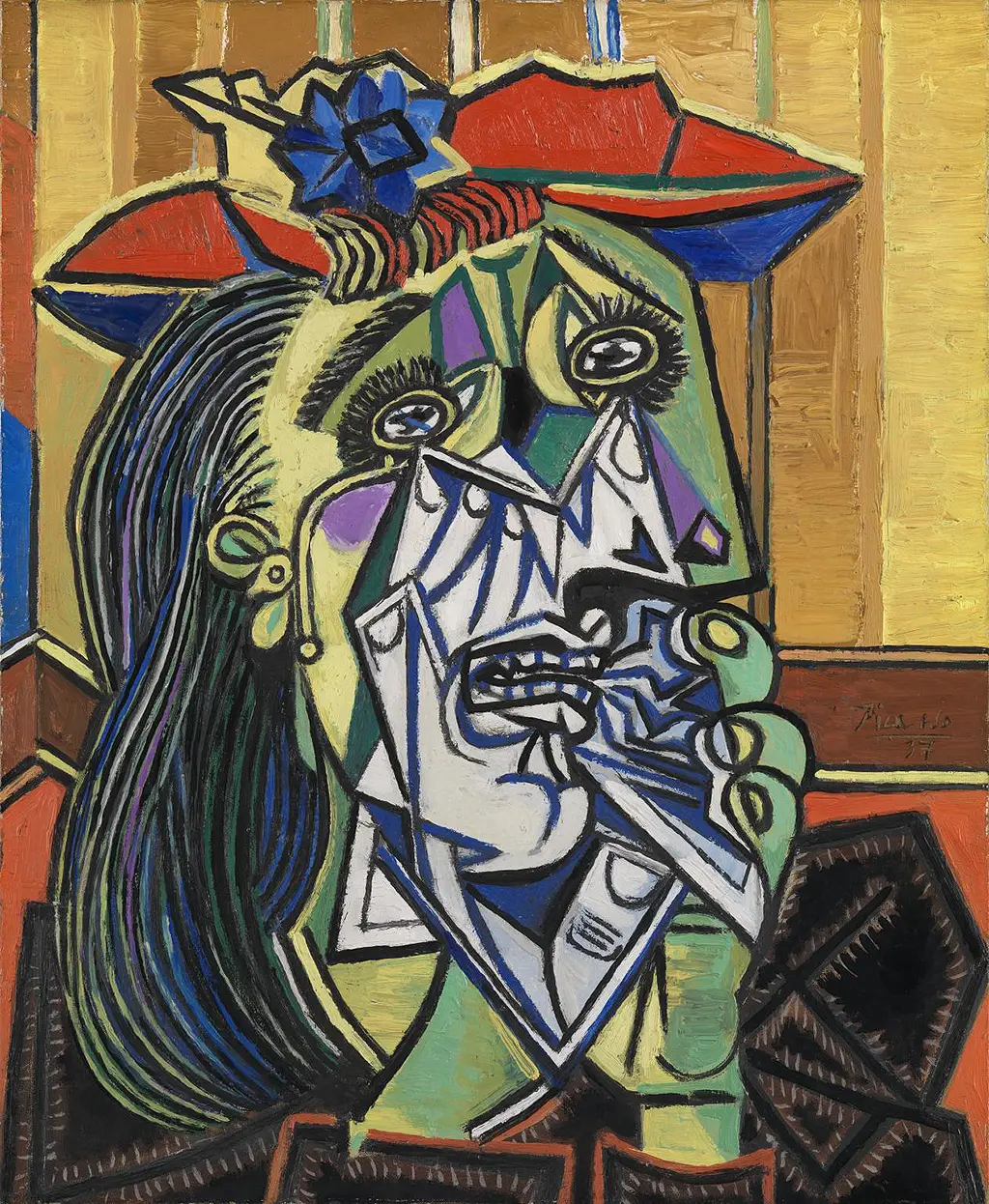The Weeping Woman captured in this bright portrait is Dora Maar, a photographer who regularly modelled for Picasso. They also had an illicit affair over many years. She would herself use this relationship to promote her own work and would eventually become a highly regarded artist in her own right. It is refreshing but rare to see a female using this male-dominated industry to her advantage. Their affair lasted from 1936 until 1944. Picasso found her to be a versatile model for his work, capturing her in all manner of different poses and moods. Picasso explained:
"...For me she's the weeping woman. For years I've painted her in tortured forms, not through sadism, and not with pleasure, either; just obeying a vision that forced itself on me. It was the deep reality, not the superficial one... Dora, for me, was always a weeping woman... And it's important, because women are suffering machines..."
Picasso explained several times that he felt inspiration to paint torment in the form of this woman. It is likely that some of this symbolises the pain of war, in a similar way to his Guernica artwork. This topic was very personal to Picasso and he allowed Dora Maar to photograph his large Guernica artwork whilst it was being put together. That painting captures the horror of war and also teaches us of the dangers of fascism which were very real at that time. The artist did not see at first hand of the horror of Germany's bombing of Guernica in support of Spanish Fascist leader, Franco in the Spanish civil war, 1937. It was newspaper cuttings which proved enough to shock him into artistic action.
This ugly, divisive civil war impacted Pablo through his family who would regularly inform him of their troubles. His response was to protest through his art, making use of the international audience which he had built up in the preceding years of his career. Picasso would communicate his concerns through the image of a woman crying, without directly capturing the war in this artwork. The symbolism was clear to most, though, and continued a successful series of powerful, expressive work. Within the Guernica mural there is a weeping woman holding her dead child. After creating this huge artwork, Picasso produced countless spin-off paintings which extended the 'life' of this intriguing character. He was an extraordinarily prolific artist who produced many thousands of items across his career, covering a wide range of mediums and styles. He could not settle on a particular approach and was always looking for something new, which was very much a part of his charm.
This specific painting was the last in the series and brought this important spell in his career to an end. Mater Dolorosa, the weeping Virgin, can be found across much Spanish art and Picasso here uses it for his own symbolic purposes. Sculptures of her are common, with Pablo's own father producing one in his younger years. Whilst borrowing this traditional theme, Picasso's model Dora Maar was ideal for this assignment. Their close bond seemed to inspire his work and lift this artwork to become one of his most respected. The original painting is now stored at the Tate Gallery in London, UK. Other items from this series are scattered around the world in various institutions and private collections, with Picasso's work regularly coming up for auction thanks to the huge amount of items that he produced across his career. Whilst most major artworks will likely never come up for sale other than for some dramatic turn of events, many of his lesser known pieces are exchanged fairly regularly and continue to retain considerable value which, if anything, has actually risen in recent years.
"...Maar recalls that Picasso painted the Tate Gallery's Weeping Woman over several consecutive days, completing and dating the work on 26 October. It was painted at the studio in rue des Grands Augustins and the background interior decor is entirely imagined...."
The Tate Gallery
Picasso would produce many different versions of the Weeping Woman, with this one being completed on 26 October 1937. It is generally regarded as the best and also the most complex of them all. Another well known version can be found in the collection of The National Gallery of Victoria which was from around a week earlier. The artist clearly put a lot in this theme, trying out different ideas in both drawing and painting mediums. The 1930s were a particularly prolific period for Picasso and many of his other creations from this decade are also widely celebrated. It is hard to stand out within his huge and varied oeuvre, and that underlines the quality of this painting which is now considered amongst his best. Its place within the prominent Tate Modern also helps to continue to promote this particular artwork, ensuring millions of visitors see it every single every year.
The composition itself features a well presented young woman with a hat and bow in her hair crying by herself. The artist makes use of bright colours which contrast against black lines, many of which are used to create form. For example, most items of her face are outlined in black. He makes use of reds, yellows, greens, blues and purples within a diverse palette. He deliberately alters angles away from reality, as well as the proportions of her face and body. Her fingers wrap over from the right hand side and are clearly oversized in relation to her jaw and mouth. She appears to be crying into a white handkerchief, though its form is also blended into the items nearest to it. Cubism involved changing the three dimensional world that we understand, where different objects will interact with each other in different ways. Her wavy hair features lines of black with purple and green which provides perhaps the most intense part of the painting. The background is bright but simple, with the artist leaving is signature on the right hand side of the canvas, about half way up.
To take the pain and suffering of war as inspiration for art is not rare. However, in this example Picasso focuses entirely on a single figure, who is mourning the death of her child. She would appear in Guernica and then be repeated elsewhere many times as a single figure. Both of these artworks were completed in 1937 and this would become a critical year in Picasso's development. At the time he was experiencing the Spanish Civil War whilst also having a passionate affair. Dora Maar herself was an accomplished photographer who captured the life of Picasso in great detail right across this significant year. Much of what we know about his preparation for Guernica was from her photographs of him in and around his studio. He concentrated on different parts of the mural with individual study pieces and that is how the Weeping Woman would start to have a life of her own. To see work that was so immediate, produced shortly after the bombing of certain Basque villages, underlined how the artist would draw on his emotions in order to get the best out of his considerable technical abilities.
Whilst Weeping Woman, and the larger mural from which it derives, Guernica, are undoubtably two of the most important Cubist artworks from right across the 20th century, there are also many other exciting and influential paintings to enjoy from Picasso's career. We are all aware of the masterpiece that was Les Demoiselles d'Avignon, a Cubist portrait of multiple female figures based on a street in Barcelona. There was also the bright outdoor setting that provided his Mediterranean Landscape that continues to prove particularly popular in the present day and is continually purchased as an art print. Other notable portraits included Girl Before a Mirror and Old Guitarist which are stylistically different but both offer an insight into the brilliance of this artist's imagination, as well as the technical qualities that he possessed which were able to successfully turn this creativity into popular and artistically influential paintings, drawings, ceramics and sculptures.
The exciting artwork has been out on display at the Tate Modern in London since 1987. The Tate itself has a huge, varied collection of art that is separated out across its different venues, most of which are in the capital city. They have recently expanded the Tate Modern in order to offer even more exbition rooms and also held a prestigious Picasso exhibition just a few years ago. You will discover many of the finest names in 19th and 20th century art within this venue, as part of its impressive permanent collection. Some of the highlights include work from Monet, Braque, Klee and Kirchner plus there are also regular high profile exhibitions which offer new items on loan for several months at a time. It is currently one of the most visited art venues in the world, ranking well against the likes of MoMA and the Louvre and also offers free entry for those looking to browse the permanent collection. The piece is believed to have been received in 1987 as part of a complex purchase procedure which included taxes in lieu as well as some collaborative funding which ultimately raised enough money.
The painting has had very few owners over the years, making its lineage very easy to track. Documentation around 20th century art is also generally much more comprehensive too. Roland Penrose is believed to have bought the painting directly from the artist just a few weeks after its completion. He was closely linked to events in Spain at the time, helping to raise funds for the Spanish Republican Government by organising a tour of Picasso's Guernica in the year that followed. He also had an affair with Peggy Guggenheim who is one of the most famous art collectors in history. He collected a large number of other artworks over the years and was also heavily involved in the European Surrealist movement, with himself also being an artist. He handed over this painting to his son, Antony, whom he had with his second wife, photographer Lee Miller. After receiving the artwork in the 1960s, he was later forced to part with it due to outstanding taxes owed to the Commissioners of Inland Revenue in 1987.



